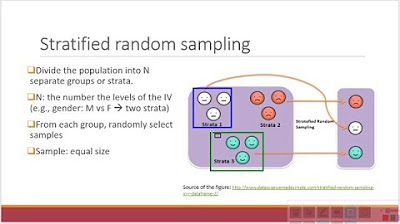Sampling 03: Stratified Random Sampling
TLDRThe transcript discusses stratified random sampling, a method to enhance the representativeness of a sample by dividing the population into different groups or strata. It uses the example of a population with 40 women and 60 men to illustrate how simple random sampling can lead to unrepresentative results. The solution is to first stratify the population by gender and then take random samples from each stratum, ensuring the sample maintains the population's ratios. This method can be further refined by considering additional factors, such as smoking habits, to create more strata and achieve a more accurate and representative sample.
Takeaways
- 🔍 Stratified random sampling is a method used to increase the representativeness of a sample by dividing the population into different groups or strata.
- 📝 The population is first segmented based on certain characteristics that are relevant to the study, such as gender or smoking habits.
- 🎯 Each stratum is intended to be homogeneous within itself, with little variability, but with significant variability between different strata.
- 🥼 Simple random samples are then taken from each stratum, ensuring that the sample maintains the proportionate representation of the population.
- 🔄 It is possible to have multiple strata in a stratified random sampling design, allowing for a more nuanced understanding of the population.
- 👥 An example given in the script involves a population of 40 women and 60 men, where the goal is to measure cholesterol levels.
- 🎲 With simple random sampling, there's a chance of getting unrepresentative samples, such as more women than men or vice versa.
- 🌟 Stratified sampling ensures that the final sample is both random and representative, by selecting predetermined numbers from each stratum.
- 📊 This method can improve the accuracy of statistical analysis by reducing sampling error and ensuring that all segments of the population are adequately represented.
- 🔎 The process can be further refined by considering additional factors for stratification, creating a more complex but potentially more accurate sampling design.
- 📈 Stratified random sampling is particularly useful when the population has distinct subgroups that are important to the research question at hand.
Q & A
What is stratified random sampling?
-Stratified random sampling is a method of sampling that divides the population into different groups, or strata, and then takes random samples from each stratum to ensure representativeness in the overall sample.
Why is representativeness important in sampling?
-Representativeness is important in sampling because it ensures that the sample accurately reflects the characteristics of the entire population, leading to more reliable and valid results in statistical analysis.
How does stratified random sampling differ from simple random sampling?
-Stratified random sampling differs from simple random sampling in that it divides the population into subgroups based on specific characteristics before taking random samples from each subgroup, ensuring that these characteristics are proportionally represented in the sample.
What was the population example given in the script?
-The population example given in the script consisted of 40 women and 60 men, and the focus was on measuring their cholesterol levels.
What could be a potential issue with a simple random sample in the given example?
-A potential issue with a simple random sample in the given example is that it might not be representative of the population's gender ratio, potentially leading to skewed results regarding cholesterol levels.
Outlines
📊 Stratified Random Sampling Method
The paragraph discusses the method of stratified random sampling, emphasizing its purpose to increase the representativeness of a sample. It uses an example of a population with 40 women and 60 men to illustrate the process. The speaker explains that simple random sampling might not always yield a representative sample, as the ratio of women to men could be skewed. However, by stratifying the population into different groups (strata), such as men and women, and then taking random samples from each stratum, the representativeness of the sample is maintained. The example continues to show how the sample would consist of four women and six men, ensuring the correct ratio is maintained in each sample. The concept is further expanded by introducing another factor, smoking, to create four strata and demonstrating how to form a stratified random sample by selecting individuals from each stratum.
Mindmap
Keywords
💡Stratified Random Sampling
💡Representativeness
💡Random Sample
💡Population
💡Cholesterol Level
💡Strata
💡Mutually Exclusive
💡Variability
💡Sample Size
💡Simple Random Sample
💡Generalize
Highlights
Stratified random sampling is introduced as a method to improve representativeness in sampling.
The population is divided into different groups or strata to ensure a more accurate reflection of the whole.
An example is given with a population of 40 women and 60 men where the goal is to measure cholesterol levels.
Simple random sampling may result in unrepresentative samples due to random chance.
Stratification helps to address the issue of unrepresentative samples by ensuring a specific ratio of subgroups in the sample.
In the given example, the population is stratified into two groups: men and women.
Random samples are then taken from each stratum to maintain representativeness.
By stratifying and sampling, the ratio of men to women in the sample stays consistent with the population.
Different individuals are selected in each stratum for different samples, but the overall ratio is maintained.
Stratified random sampling can be further broken down into more strata based on additional factors, such as smoking.
The process of stratified random sampling ensures that each subgroup is proportionally represented in the overall sample.
This method can be applied to any factor that may influence the variable of interest, not just gender.
Stratified random sampling increases the likelihood of obtaining a sample that is representative of the population's diversity.
The technique is particularly useful when dealing with large and complex populations.
Stratified random sampling balances the trade-off between simplicity and precision in sampling.
This method enhances the reliability and validity of the results obtained from sampling.
Stratified random sampling is a valuable tool in research design and statistical analysis.
The process ensures that each subgroup within the population has a voice in the sample.
By maintaining representativeness, stratified random sampling provides a more accurate depiction of the population's characteristics.
Transcripts
Browse More Related Video

population sample parameter statistic | Gourav Manjrekar

Research Methods 1: Sampling Techniques

Introduction to sampling distributions | Sampling distributions | AP Statistics | Khan Academy

4.2 Probability Sampling Techniques

SYSTEMATIC RANDOM SAMPLING

What Are The Types Of Sampling Techniques In Statistics - Random, Stratified, Cluster, Systematic
5.0 / 5 (0 votes)
Thanks for rating: